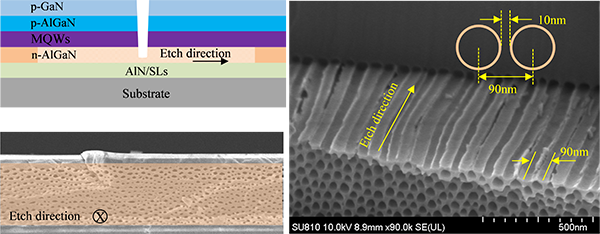UVC-LEDs with light emission from 200-280 nm were mainly used to introduce germicidal radiation to microorganisms (bacteria, viruses, spores and other pathogens). It damages and changes the structure of DNA (deoxyribonucleic acid), so that the microorganisms die or loss the reproduction capability immediately, and achieve the purpose of sterilization and disinfection. UVC-LED has a great market potential with a wide range of applications in air sterilization, surface disinfection and water treatment, because of its stability and safety, environmental friendliness, long lifetime, low maintenance cost and zero chemical residue. However, the biggest challenge for the UVC-LED is its low external quantum efficiency and insufficient output optical power density under high current. In addition to the poor quality of the Al-rich UVC epitaxial material and the low injection efficiency of the carrier, the main reason for the low quantum efficiency is due to the low extraction efficiency of TM mode (E//C) photons. TM mode UVC photons are confined in the epitaxial layer and suffer from the total internal reflection and re-absorption. Previous methods known to improve the light extraction of visible LEDs have little effect on TM mode light in the UVC-LED.
The research group led by Dr. Yufeng Li and Prof. Feng Yun from Xi'an Jiaotong University put forward a simple and easy method to improve the TM mode light emission of a 290 nm UVC-LED. The related results are published in Photonics Research, Vol. 8, Issue 6, 2020 (Yufeng Li, Chenyu Wang, Ye Zhang, et al. Analysis of TM/TE mode enhancement and droop reduction by a nanoporous n-AlGaN underlayer in a 290 nm UV-LED[J]. Photonics Research, 2020, 8(6): 06000806). With the help of their previous experience in electro-chemical etching of GaN material, the researchers converted the Al-rich n-AlGaN, which is more difficult to be etched, into a periodic nanoporous grating layer, while maintaining its conductivity. The random photon scattering by the nanoporous layer greatly reduces the total internal reflection and re-absorption of the TM mode photons by the p-GaN layer and the active region. As a result, it promotes the light extraction of TM mode photons, and increases the top and side PL emission intensity by 1.57 and 22 times, respectively. The nanoporous grating layer also relaxes the stress produced by compressive strain, reduces the quantum-confined Stark effect (QCSE), and inhibits the non-radiative recombination. The output power of the UVC-LED with nanoporous grating layer is increased by 36.5%. The EQE droop at 100 mA was 61% for the reference sample and 36% for the nanoporous sample.

Epitaxial structure of the scribed via holes and nanoporous grating layer.
Prof. Feng Yun of Xi'an Jiaotong University considers it a simple and reliable approach to greatly improve the external quantum efficiency, which can be widely applied in commercial UVC-LED chips. Eventually, UVC-LEDs with much improved efficiency can replace the traditional deep ultraviolet light source, and provide final solutions for the public health and safety.


